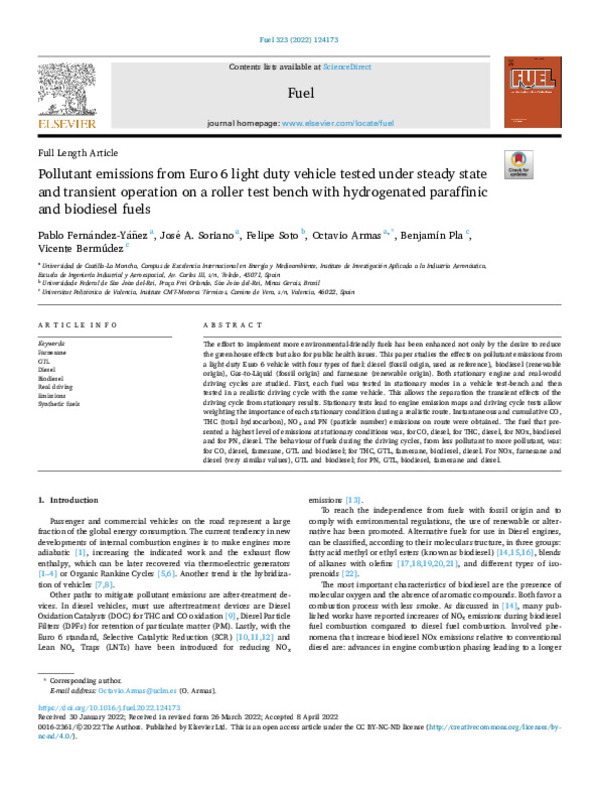JavaScript is disabled for your browser. Some features of this site may not work without it.
Buscar en RiuNet
Listar
Mi cuenta
Estadísticas
Ayuda RiuNet
Admin. UPV
Pollutant emissions from Euro 6 light duty vehicle tested under steady state and transient operation on a roller test bench with hydrogenated paraffinic and biodiesel fuels
Mostrar el registro sencillo del ítem
Ficheros en el ítem
| dc.contributor.author | Fernández-Yáñez, Pablo
|
es_ES |
| dc.contributor.author | Soriano, José A.
|
es_ES |
| dc.contributor.author | Soto, Felipe
|
es_ES |
| dc.contributor.author | Armas, Octavio
|
es_ES |
| dc.contributor.author | Pla Moreno, Benjamín
|
es_ES |
| dc.contributor.author | Bermúdez, Vicente
|
es_ES |
| dc.date.accessioned | 2023-06-23T18:01:50Z | |
| dc.date.available | 2023-06-23T18:01:50Z | |
| dc.date.issued | 2022-09-01 | es_ES |
| dc.identifier.issn | 0016-2361 | es_ES |
| dc.identifier.uri | http://hdl.handle.net/10251/194506 | |
| dc.description.abstract | [EN] The effort to implement more environmental-friendly fuels has been enhanced not only by the desire to reduce the greenhouse effects but also for public health issues. This paper studies the effects on pollutant emissions from a light-duty Euro 6 vehicle with four types of fuel: diesel (fossil origin, used as reference), biodiesel (renewable origin), Gas-to-Liquid (fossil origin) and farnesane (renewable origin). Both stationary engine and real-world driving cycles are studied. First, each fuel was tested in stationary modes in a vehicle test-bench and then tested in a realistic driving cycle with the same vehicle. This allows the separation the transient effects of the driving cycle from stationary results. Stationary tests lead to engine emission maps and driving cycle tests allow weighting the importance of each stationary condition during a realistic route. Instantaneous and cumulative CO, THC (total hydrocarbon), NOx and PN (particle number) emissions on route were obtained. The fuel that presented a highest level of emissions at stationary conditions was, for CO, diesel, for THC, diesel, for NOx, biodiesel and for PN, diesel. The behaviour of fuels during the driving cycles, from less pollutant to more pollutant, was: for CO, diesel, farnesane, GTL and biodiesel; for THC, GTL, farnesane, biodiesel, diesel. For NOx, farnesane and diesel (very similar values), GTL and biodiesel; for PN, GTL, biodiesel, farnesane and diesel. | es_ES |
| dc.description.sponsorship | The authors would like to thank the funding provided by the Spanish Ministry of Science for RECUPERA project (Ref. RTI2018-095923-B-C21) and infrastructure (Ref. EQC2019-005675-P) , the donation of Farnesane fuel by AMYRIS, the donation of GTL fuel by SASOL and the discount provided by REPSOL in the purchase of diesel and biodiesel fuels. | es_ES |
| dc.language | Inglés | es_ES |
| dc.publisher | Elsevier | es_ES |
| dc.relation.ispartof | Fuel | es_ES |
| dc.rights | Reconocimiento - No comercial - Sin obra derivada (by-nc-nd) | es_ES |
| dc.subject | Farnesane | es_ES |
| dc.subject | GTL | es_ES |
| dc.subject | Diesel | es_ES |
| dc.subject | Biodiesel | es_ES |
| dc.subject | Real driving | es_ES |
| dc.subject | Emissions | es_ES |
| dc.subject | Synthetic fuels | es_ES |
| dc.subject.classification | MAQUINAS Y MOTORES TERMICOS | es_ES |
| dc.title | Pollutant emissions from Euro 6 light duty vehicle tested under steady state and transient operation on a roller test bench with hydrogenated paraffinic and biodiesel fuels | es_ES |
| dc.type | Artículo | es_ES |
| dc.identifier.doi | 10.1016/j.fuel.2022.124173 | es_ES |
| dc.relation.projectID | info:eu-repo/grantAgreement/AEI/Plan Estatal de Investigación Científica y Técnica y de Innovación 2017-2020/RTI2018-095923-B-C21/ES/RECUPERACION DE ENERGIAS RESIDUALES EN VEHICULOS LIGEROS. IMPACTO TECNOLOGICO/ | es_ES |
| dc.relation.projectID | info:eu-repo/grantAgreement/MICINN//EQC2019-005675-P/ | es_ES |
| dc.rights.accessRights | Abierto | es_ES |
| dc.contributor.affiliation | Universitat Politècnica de València. Escuela Técnica Superior de Ingeniería del Diseño - Escola Tècnica Superior d'Enginyeria del Disseny | es_ES |
| dc.description.bibliographicCitation | Fernández-Yáñez, P.; Soriano, JA.; Soto, F.; Armas, O.; Pla Moreno, B.; Bermúdez, V. (2022). Pollutant emissions from Euro 6 light duty vehicle tested under steady state and transient operation on a roller test bench with hydrogenated paraffinic and biodiesel fuels. Fuel. 323:1-12. https://doi.org/10.1016/j.fuel.2022.124173 | es_ES |
| dc.description.accrualMethod | S | es_ES |
| dc.relation.publisherversion | https://doi.org/10.1016/j.fuel.2022.124173 | es_ES |
| dc.description.upvformatpinicio | 1 | es_ES |
| dc.description.upvformatpfin | 12 | es_ES |
| dc.type.version | info:eu-repo/semantics/publishedVersion | es_ES |
| dc.description.volume | 323 | es_ES |
| dc.relation.pasarela | S\486975 | es_ES |
| dc.contributor.funder | Agencia Estatal de Investigación | es_ES |
| dc.contributor.funder | Ministerio de Ciencia e Innovación | es_ES |








